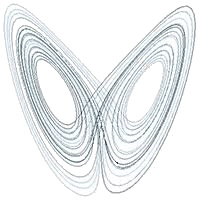The Butterfly Effect, simply put, is the phenomenon where a small change in the initial conditions may pile up over time, and in the end, create a massive effect. Just like a small snowball rolled downhill may gather more snow on the way and by the time it reaches the base, it turns huge!
This forms the basis of a rather emerging field of science: "Chaos". It is just what the name suggests - the study of highly complex systems that are sensitive to very slight changes, sometimes, even to the ones they themselves create!
Emergence of a New Science
What else would've been a better field for the emergence of Chaos than Meteorology, where even a small change in the wind speed may delay monsoon by days!

The Butterfly Effect was discovered for the first time in 1961, in the laboratory of one such MIT Meteorologist, Edward Lorenz. Lorenz was more of a mathematics person than his colleagues. He had never been much interested in pure Meteorology, instead, he wanted to capture the beauty of weather by mathematical formulas, which would allow Meteorologists like him to predict the weather not just days, but months, even years in advance!
This quest of his led him to setting up a computer in his lab, the Royal McBee. Computers at that time were neither as advanced, nor as common as today. Instead they were huge beasts run by vacuum tubes and outputting the results only through print. Because of this, his lab was indeed a center of attraction for the whole department!
Lorenz believed that weather, just like many other physical phenomenons, could be defined by some set of equations, which when solved, would predict the future weather. And he wasn't the only person with this belief. Most scientists at that time used to believe that nature is nothing but a set of equations given a physical form. And that if they can obtain those raw equations, they could make anything work according to them! This might seem pretty straight-forward and logical. Unfortunately, it isn't.
However, Lorenz was successful in modelling a pretty simple weather mechanism in his computer, governed by 12 differential equations. What his computer did was intake the initial conditions for the weather, and based on those equations, it calculated the result and printed it in the form of a string of numbers (which only Lorenz, and few others in the department were able to understand).
One day, Lorenz wanted to re-examine a set of results. While doing so, instead of starting the process all the way from the start, he entered the values from halfway between the previous result, expecting it to exactly duplicate the previous results. However, this time he found something strange. The second result remained similar to the previous result for some time, but soon, subtle differences started to appear.It wasn't long when both the results became completely contrary! At first he thought it was a hardware problem and so he inspected all the vacuum tubes, which were all fine.
Soon, he realized where the problem lied. The Royal McBee stored the values up to 6 decimal places in it's memory, and that is what it calculated. In the printout however, to save space, the result was rounded off to just 3 decimal places. So the values Lorenz entered the second time were just 3 decimal places, and hence not precise. This caused a small difference which started to pile up and resulted in a huge difference.
Lorenz was quite attracted by what he had just observed and so he started working on it. He found that if in such a complex and repeating system, a set of variables are plotted against time, then the points on graph seem to follow somewhat the same path as the last cycle, but with slight difference. And as the number of cycles increased, the difference became large. This graph was named the "Lorenz attractor" and it resembled the wings of a butterfly.

The Butterfly Effect was hence discovered! Though, it's technical name became "Sensitive Dependence on Initial Conditions" (somebody needs to learn how to name).
So Can a Butterfly Really Cause Hurricanes?
The Butterfly Effect is usually referred to by the notation that a butterfly flapping it's wings somewhere, may cause a hurricane elsewhere. However, this notation might be slightly flawed. A butterfly flapping it's wings may indeed change the wind speed or direction, even if by a minute amount, however, there is practically nothing a butterfly may do that might pile up to "cause" a hurricane.
Now, what's interesting here is the difference between "cause" and "effect". A change in the flapping of a butterfly may change wind speed and/or direction, which may pile up over time and cause a change in winds as whole, which might ultimately effect the time or place of a hurricane. The hurricane, however, may not be "caused" by the movements of the butterfly entirely. So finally, a butterfly flapping it's wings may "effect" the hurricane, but not cause it.
If you are still not sure whether the Butterfly Effect is real or not, here's something for you. An Institution rejecting an application for admission is pretty common right? What havoc could it cause? Well interestingly, in 1905, the Vienna Academy of Fine Arts rejected an application twice. This ultimately led to the death of over 60 million people! "How?", you ask. Well, the applicant was a German fellow named Adolf Hitler.
Check out my blog [scienceaholic.com website not found] It offers quality scientific content, ranging from old theories to latest discoveries, everything in the most comprehensible form, without fiddling with any technical terminologies, to make science fun for all.
Webmaster's note: My interpretation of the butterfly effect is that conditions already exist that would result in a hurricane except for the lack of the tiniest amount of energy. That tiniest amount of energy is added to the system by the flapping of the butterflies wings, which triggers the hurricane. So I guess the answer to the question "can a butterfly really cause a hurricane?" depends upon your definition of the word "cause".
